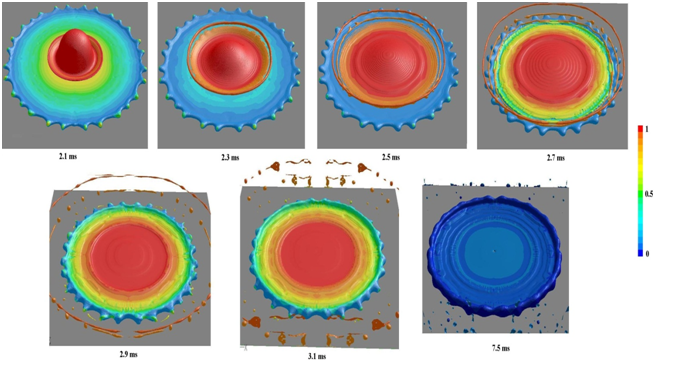Simulation of HVOF spraying
The overall flowdynamics are quantitatively presented by the contour plots.The gas temperature increase sharply within the combustion chamber and reaches an area of stability within the barrel before decaying in the external environment. The gas velocity increases sharply in the convergent–divergent nozzle, develops maxima and minima, decreases marginally across the barrel and again develops maxima and minima outside the barrel where the free jet is developed. This pattern of expansion and compression waves is repeated until mixing with the surrounding atmosphere which eventually dissipates the supersonic jet.
Simulation of Droplet Impact

During the process of thermal spray coating, molten powders are sprayed and deposited on substrates to generate protective coatings. It is essential to have a clear understanding of the physics of droplet impingement on the surface of substrates for better control of the generation of splats and the structure of coating. A numerical model is developed to simulate the dynamics of transient flow during the impingement process, including spreading, break-up, air entrapment and solidification. The computation is achieved using the technique of volume of fluid surface tracking within a fixed Eulerian structured mesh. The three-dimensional simulation is able to accurately give a demonstration of dynamic flow patterns such as the generation of fingers, satellite droplets and pores during impingement. The numerical model is validated with experimental data from the tin droplet measurement and excellent agreement is found between the simulation and the experiment
Simulation of Porous Particle Impact

The deposition of solid particles requires sufficient deformation of the particles as a result of a high impact. This report is a continuation of our previous work to study the bonding mechanism for thermally sprayed solid particles. WC-Co powder, is studied by considering the porosity inside the particles. The detailed deposition mechanism is examined by dynamically tracking the particle impingement using finite element analysis (FEA) models. The results confirm that the deposition of high-speed solid particles is caused mainly by the particle deformation and further implies that deformation is enhanced with increase in porosity alone. Therefore, a possible way to increase the deposition efficiency of hard cermet coating could be to use a properly designed porous powder